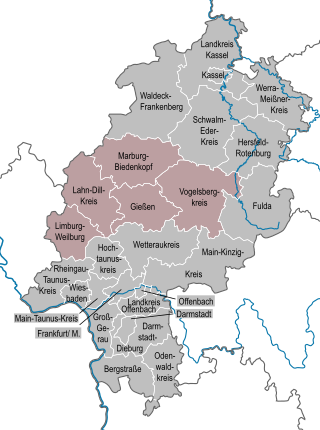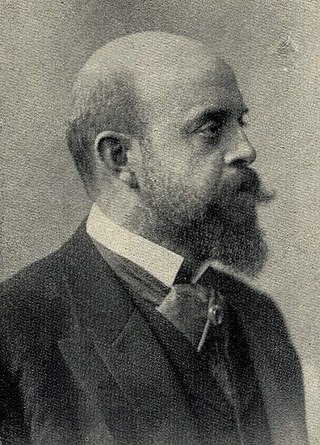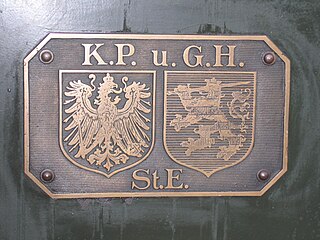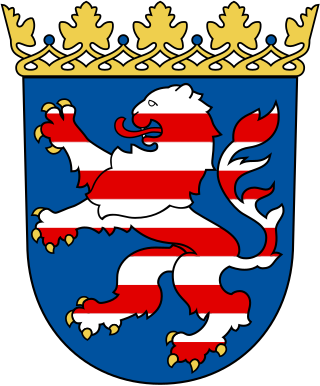
The Hessisches Staatsarchiv Marburg (HStAM, "Hessian State Archives in Marburg") is one of the three archives of the Hessisches Landesarchiv and is based in Marburg upon Lahn. [1]

The Hessisches Staatsarchiv Marburg (HStAM, "Hessian State Archives in Marburg") is one of the three archives of the Hessisches Landesarchiv and is based in Marburg upon Lahn. [1]

Marburg is a university town in the German federal state (Bundesland) of Hesse, capital of the Marburg-Biedenkopf district (Landkreis). The town area spreads along the valley of the river Lahn and has a population of approximately 76,000.

Giessen is one of the three Regierungsbezirke of Hesse, Germany, located in the middle of the state. It was created on 1 January 1981 from the districts of Giessen, Lahn-Dill and Limburg-Weilburg and the Vogelsbergkreis, all formerly belonging to Darmstadt, and Marburg-Biedenkopf, formerly belonging to Kassel.
Giessen is a Kreis (district) in the middle of Hessen, Germany. Neighboring districts are Marburg-Biedenkopf, Vogelsbergkreis, Wetteraukreis, and Lahn-Dill.
Marburg-Biedenkopf is a Kreis (district) in the west of Hesse, Germany. Neighboring districts are Waldeck-Frankenberg, Schwalm-Eder, Vogelsbergkreis, Gießen, Lahn-Dill, Siegen-Wittgenstein.
The Vogelsbergkreis is a Kreis (district) in the middle of Hesse, Germany. Neighbouring districts are Schwalm-Eder, Hersfeld-Rotenburg, Fulda, Main-Kinzig, Wetteraukreis, Gießen and Marburg-Biedenkopf.

August Bodo Wilhelm Clemens Paul von Trott zu Solz was a German politician.

Hessischer Rundfunk, shortened to HR, is the German state of Hesse's public broadcasting corporation. Headquartered in Frankfurt, it is a member of the national consortium of German public broadcasting corporations, ARD.

Biedenkopf is a spa town in western Hesse, Germany with a population of 13,491 (2020).

Cölbe is a municipality in Marburg-Biedenkopf district in Hesse, Germany.

The Grand Duchy of Hesse and by Rhine was a grand duchy in western Germany that existed from 1806 to 1918. The Grand Duchy originally formed from the Landgraviate of Hesse-Darmstadt in 1806 as the Grand Duchy of Hesse. It assumed the name Hesse und bei Rhein in 1816 to distinguish itself from the Electorate of Hesse, which had formed from neighbouring Hesse-Kassel. Colloquially, the grand duchy continued to be known by its former name of Hesse-Darmstadt.

Selters is a village in the district Limburg-Weilburg, Hesse, Germany. It is situated at the Taunus side of the river Lahn and belongs to the municipality Löhnberg. The village has a total population of 319.
The Lohra tomb was a megalithic monument outside Lohra near Marburg in north central Hesse, Germany. It is one of the lesser known among its type in Central Europe. It dates to the late Neolithic, probably just after 3000 BC. It belongs to the gallery graves of the Wartberg culture, but is unique among them because of its rich ceramic assemblage.

The Royal Prussian and Grand-Ducal Hessian State Railways was a state-owned network of independent railway divisions in the German states of Prussia and Hesse in the early 20th century. It was not, as sometimes maintained, a single state railway company.

The civil flag of Hesse, Germany consists of a bicolor of a red top and a bottom white stripe, in the proportion 3:5. The state flag is similar, except it is emblazoned with the state coat of arms in the centre, and may only be used by government departments and services.

Altenberg Abbey is a former Premonstratensian nunnery situated between Solms and Wetzlar, Hesse, Germany. It was founded in c. 1170 and dissolved in 1802. It had a strong connection with the House of Nassau, several of whom were nuns and abbesses, and some family members, including Otto I, Count of Nassau, were buried here; it was also a burial place for the Counts of Solms. The buildings were seriously damaged by a fire in 1952. Those that survive accommodate a meeting centre for the local deanery and since 2018 a small Protestant religious community.
Gerhard Menk was a German historian and archivist.
Andreas Hedwig is a German archivist and since 2014 the head of the Hessian State Archive.

Friedrich Uhlhorn was an honorary professor at the Philipps-Universität Marburg, whose scientific focus was on the history of the State of Hesse and was also known for his work outside Hesse. His special scientific interest was mainly focused on the problems of historical cartography. In collaboration with Edmund Ernst Stengel, he published the Geschichtlichen Atlas von Hessen, which is considered his major work. He also wrote the article Die deutschen Territorien. A: The West, which deals with the West German regional history. Likewise he was responsible as editor for the Hessisches Jahrbuch für Landesgeschichte by Bruno Gebhardt.

Count Karl von Schlitz, in full: Karl Heinrich Wilhelm Hermann Ferdinand von Schlitz, genannt von Görtz was a German politician and Standesherr in the Grand Duchy of Hesse.

The Hessian Central State Archives, Wiesbaden is a department of the Hessian State Archives and is located in Wiesbaden, the capital of the German state of Hesse. It serves alongside the Hessian State Archives, Darmstadt and the Hessian State Archives, Marburg as the main regional archives for Hesse and additionally functions as the central archives for the state government and ministries, as well as other institutions with nationwide jurisdiction.
50°48′14″N8°45′47″E / 50.8038°N 8.7630°E